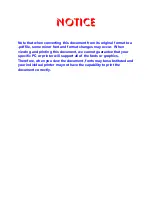
273
■
Date
d
Numbers separated by a slash (/) or a period (.) are read out as time. If “M”, “T”, “S” or “H” (upper
case) is inserted before a date, the corresponding (Japanese) era name is read out.
a
The above formats for numbers, monetary amounts, phone numbers, time and date can also
be used with double-byte characters.
a
When monetary amounts, phone numbers, time or date are read out and the string read out is
immediately preceded or followed by any of the characters shown below, the numbers will not be
delimited correctly. When you want to have monetary amounts, phone numbers, time or date read
out correctly, you should use a space as the delimiting character before and after the item.
0 to 9, A to Z (upper case), colon (:),
¥
, slash (/), period (.), hyphen (-) (double-byte or single-
byte)
■
Symbols
d
The FOMA terminal can read out the symbols shown below. (These symbols are read out as
shown when used with numbers.)
■
Other settings
d
Alphabetic letters are read out in alphabet reading, but may be read otherwise in certain
combinations.
d
Depending on the content of a sentence or description (particularly where place names or
proper nouns are used), the FOMA terminal may not read out the sentence or may read it out
incorrectly.
d
Mail is not read out in a natural voice. In some cases the sounds or stress may be difficult to
understand.
d
Items such as punctuation marks (periods and commas), line feeds and spaces serve as
separators for passages read out, except where a period (.) or comma (,) is preceded and/or
followed by numbers. In text that has no delimiting punctuation, reading is paused automatically.
Depending on the content being read out, there may be a pause before the FOMA terminal
starts speaking. The FOMA terminal may also be unable to correctly read out passages where
kanji characters are used. To ensure that the content of your received mail is read out correctly,
you should recommend the following guidelines to people with whom you frequently correspond:
a
Create your mail using katakana for nouns, particularly proper nouns such as place names and
personal names.
a
Use punctuation marks when creating a mail.
“Year”/“Month”/“Day” or “Year”.“Month”.“Day”(“Year” = 0 to 9999; “Month” = 1 to 12; “Day” = 1 to 31)
“M” “Year”/“Month”/“Day” or “M” “Year”.“Month”.“Day” (“Year” = 0 to 99; “Month” = 1 to 12; “Day” = 1 to 31)
E.g.: M10/04/20 “Meiji junen shigatsu hatsuka”
“T” “Year”/“Month”/“Day” or “T” “Year”.“Month”.“Day” (“Year” = 0 to 99; “Month” = 1 to 12; “Day” = 1 to 31)
E.g.: T8.10.15 “Taishou hachinen jugatsu jugonichi”
“S” “Year”/“Month”/“Day” or “S” “Year”.“Month”.“Day” (“Year” = 0 to 99; “Month” = 1 to 12; “Day” = 1 to 31)
E.g.: S50.3.6 “Shouwa gojunen sangatsu muika”
“H” “Year”/“Month”/“Day” or “H” “Year”.“Month”.“Day” (“Year” = 0 to 99; “Month” = 1 to 12; “Day” = 1 to 31)
E.g.: H17.10.3 “Heisei junananen jugatsu mikka”
$(dollars)
→
doru
%
(percent)
→
paasento
¥
(yen)
→
en
°
(degrees)
→
do
℃
(degrees)
→
do
¥
(yen)
→
en
$
(dollars)
→
doru
%
(percent)
→
paasento
(mm)
→
miri
(kilograms)
→
kiro
(cm)
→
senchi
(meters)
→
meetoru
(grams)
→
guramu
(tons)
→
ton
(ares)
→
aaru
(hectares)
→
hekutaaru
(liter)
→
rittoru
(watts)
→
watto
(calories)
→
karorii
(dollars)
→
doru
(cent)
→
sento
(percent)
→
paasento
(millibars)
→
miribaaru
(pages)
→
peeji
mm(millimeters)
→
mirimeetoru
cm(centimeters)
→
senchimeetoru
km(kilometers)
→
kiromeetoru
mg(milligrams)
→
miriguramu
kg(kilograms)
→
kiroguramu
cc(cc)
→
siisii
m
2
(square meters)
→
heihoumeetoru
Eg.: 2006/9/22
2006/09/22
2006.9.22
2006.09.22
“Nisenrokunen juunigatsu itsuka”
Summary of Contents for N903i
Page 208: ......
Page 499: ...497 dIndex Quick Manual Index 498 Quick Manual 506 ...
Page 576: ...Kuten Code List ...
















































